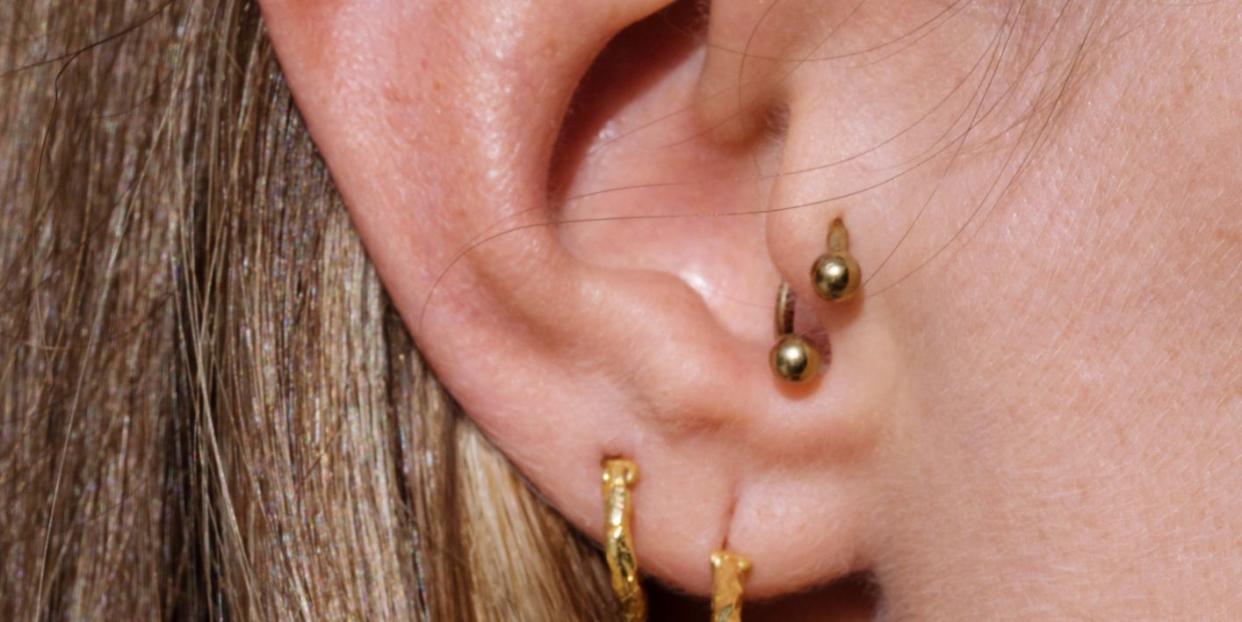Everything to Know About Migraine Piercings—Do They Really Work?

If you suffer from chronic migraines, you’ve probably already tried countless treatment options to ease that throbbing headache pain. And there’s a lot of them out there—from special migraine relief products to changes in diet to massages to botox injections—but one of the most unique methods has to be a migraine piercing, or a daith ear piercing that some say has a numbing effect. But the question is, does it really work?
We spoke to Lauren Natbony, M.D., headache specialist and member of the Prevention’s Medical Review Board, to give you everything you need to know about daith piercings, if they really are effective, and maybe why you should skip the piercing studio on your path to migraine symptom relief.
What is a daith piercing?
When people speak about a migraine piercing, they are most commonly referring to a piercing in the cartilage of the ear, either the daith or tragus. Daith piercings are done in the cartilage ridge inside the outer ear called the helix.
According to Dr. Natbony, medical director of Integrative Headache Medicine of New York and an assistant clinical professor of neurology in the Department of Headache and Facial Pain at the Icahn School of Medicine at Mount Sinai, the use of cartilage piercings as a treatment for migraines appears to have stemmed from acupuncture, a form of traditional Chinese medicine, that involves inserting needles into specific points on the body to treat various ailments. “There are points on the daith and tragus that acupuncturists may stimulate when treating migraine pain,” she explains. “Thus, some people view these piercings as more permanent forms of acupuncture.”
Can a daith piercing help with migraine pain?
The area of a daith piercing corresponds to an acupuncture point that is targeted to relieve migraine headache pain, says Dr. Natbony.
“The theory is that piercing this acupuncture point can provide more permanent pain relief. It has also been suggested that daith piercings might work by stimulating the vagus nerve, which has a branch on the surface of the ear, at the daith. The vagus nerve plays an important role in migraines,” she explains. “Stimulating the vagus nerve may decrease transmission of pain signals and reduce the excitability of the cerebral cortex of the brain.”
However, as Dr. Natbony points out, there are no randomized controlled studies proving efficacy and there is no scientific data showing a reason that daith piercings should work.
Daith piercing risks
As we pointed out, the evidence for daith piercing benefits is purely anecdotal (meaning the perceived benefit is likely due to a placebo effect), and there is no scientific research that supports it. Dr. Natbony explains that “there are also potential risks of piercing such as infection and pain. Thus, most neurologists do not recommend daith piercings as a treatment for migraines.”
For patients that are curious about daith piercing, a visit with an acupuncturist may be the best next step, says Dr. Natbony. “An acupuncturist can needle this specific acupuncture point to see if there is benefit,” she says. “A temporary stud can even be placed on this acupoint and can be worn for a few weeks to gauge effect.”
Other migraine treatment options
While there is no cure for migraines, there are many effective treatments. Dr. Natbony says that a comprehensive treatment strategy is key to preventing migraine attacks and stopping them quickly once they start.
“For those interested in complementary treatments for migraine, there are an array of evidence-based therapies available including acupuncture, biofeedback, mindfulness-based meditation, and relaxation training,” she adds. “The efficacy of these modalities in reducing migraine frequency and severity is comparable to that of many pharmacologic treatments.” Dr. Natbony also notes that regular exercise can also be extremely beneficial in improving overall pain management.
You Might Also Like

